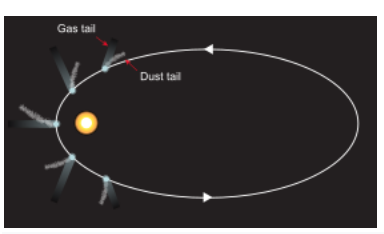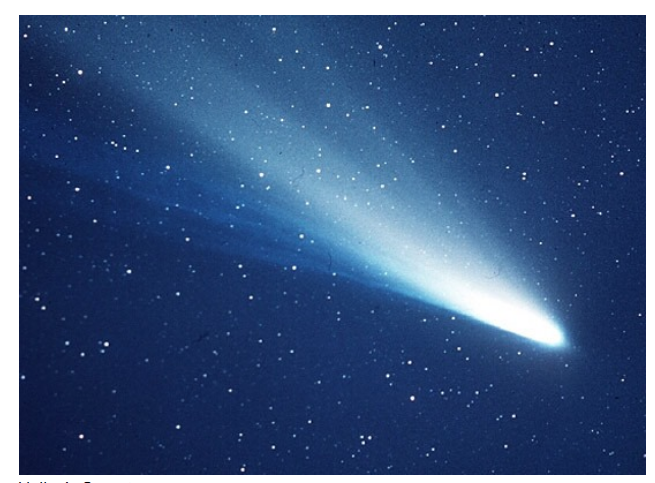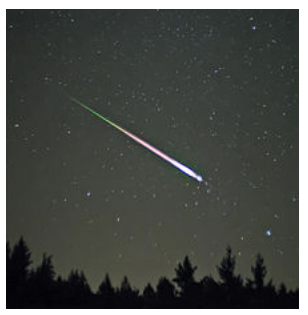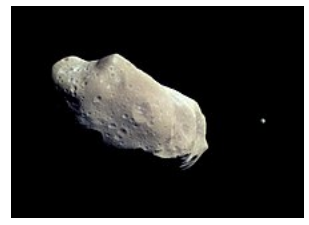Announcements
You may notice that some of the links to sources of images no longer work. That's no big deal, because the important thing is that the images are in the lessons.
Please write your essays and short answers in English, using the web site "Google Translate" to translate them, and write NES at the top of your essays so as not to lose marks in case the web site makes spelling or grammatical errors.
Lesson 8) Other Celestial Bodies in the Solar System
In this lesson, we’re going to discuss the bodies in the solar system that are smaller than the planets: comets, meteors, asteroids, and dwarf planets. While these bodies are less influential than the planets, they nevertheless present some interesting magical findings, so without any further ado, let’s hop to it!
Comets
A comet is a small body that’s composed of water ice in addition to various other ices, like frozen methane and carbon dioxide, as well as rock and dust. Their sizes range from a few hundred meters to tens of kilometers. If one passes close enough to the Sun, it gets warm enough that the ice melts and evaporates into an atmosphere, called the coma, consisting of gas and dust. The remaining solid part of the comet, meanwhile, is called the nucleus. The light and radiation from the Sun actually exerts a pressure that, along with the solar wind, can push this atmosphere away from the comet, forming a tail or two: one of gas and one of dust.

Typical direction of tails during a comet's orbit near the Sun.
Source: here
Most comets originate far from the Sun. Some of them get pulled into orbits that come close to the Sun by the gravity of one of the planets or, for those extremely far away from our solar system, by a passing star. They don’t usually stay close, though: after making their way around the Sun, they either never return or follow a highly elliptical orbit like the one shown in the picture above. The ones that do return are grouped into short-period comets, with a period of less than 200 years, and long-period comets.
The most famous comet, Halley’s Comet, was named after Edmond Halley, the English astronomer who, in 1705, discovered its period of about 75 years. It is so famous that a rock band active from 1952 until the death of its leader, Bill Haley, in 1981, is called Bill Haley & His Comets. The space rock has been observed several times since 240 B.C.E., and it can be seen with the naked eye every time it comes close to the Sun. The last time it was seen was in 1986, when several spacecraft approached it to examine its chemical composition. It didn’t appear particularly bright from Earth then because it was on the opposite side of the Sun, but it will be much more spectacular when it next returns in 2061. That’s something for you young folks to look forward to.
 Halley’s Comet.
Halley’s Comet.
Source: here
Another famous comet is the Hale-Bopp Comet, discovered independently on July 23, 1995 by two American observers, Alan Hale and Thomas Bopp. At its most luminous, it shone brighter than any star except Sirius, and its dust tail extended 40 to 45 degrees across the sky. Its closest approach to Earth, on March 27, 1997, was 1.315 A.U., close enough to hail us but not close enough to bop us.
Do comets have magical properties? In ancient times, Muggles used to think that they announced, and maybe even foretold, the violent death of one or more high-status people. There was a bright comet in the sky when the Roman emperor Julius Caesar was stabbed to death, and a connection was made between the comet and the assassination. A few Muggles still think that comets have some divinatory power, but most of them scoff at the very idea of any sort of magic. Most wizards had no faith in the idea either: after all, they thought, what do mere Muggles know of magic?
On the other hand, since all celestial bodies reflect solar magic towards us and comets can get extremely bright, it seemed reasonable to suppose that they would reflect a lot of magic our way. And so, when Halley’s Comet last visited Earth’s neighbourhood in 1986, there was plenty of excitement within the magical astronomical community, and a lot of magical research relating to the comet was performed and published. The magical newspapers covered the arrival of the comet in great detail: they exaggerated the theories published by the researchers and presented them as established facts, as newspapers are wont to do. When nothing out of the ordinary happened and the comet had come and gone, the magical community was at a loss for an explanation. Through numerous further studies, we now know why no magic accompanied Halley’s comet: its brighter tail was made of water vapour, which transmits rather than reflects solar magic, and its dust tail was too sparse and its nucleus too small to reflect a noticeable amount of magic from so far away. It will certainly make for an intriguing subject when it returns close enough to study.
But then, eight years after Halley’s Comet’s last sighting, Voldemort returned, and more and more people, some of whom were of high status, suffered a violent death. A few wizards began to suspect that the ancient Muggles might have been on to something. Their suspicions were strengthened when a great many witches and wizards met a violent death during the Battle of Hogwarts, a few short months after the closest approach of Hale-Bopp. If you’ve risen to a high status within the wizarding community by the time Halley returns in 2061, be afraid. Be very afraid!
Meteors, Meteoroids, and Meteorites
Have you ever seen a trail of light like the one in the image below?

Source: here
This flash of light is commonly called a shooting star, but its proper name is a meteor. It is caused by a small object entering the Earth’s atmosphere, where it is heated by friction until it becomes incandescent, leaving a trail of glowing particles behind it. Usually you can see one or two meteors an hour - if you’re in a place where the sky is dark enough - but a few times a year a lot more of them can be seen in that space of time - sometimes hundreds of them. Such a light show is called a meteor shower, which is certainly quite exciting to watch. The trails all seem to come from the same point in the sky, called the radiant. A meteor shower is named after the constellation in which the radiant is seen. For example, the meteor shower whose radiant is in the constellation Perseus is called the Perseids. And the meteor shower that originates from the constellation Leo would be called…?
What causes a meteor shower and how can you find out in advance when one will occur? As we’ve already discussed, when a comet is heated by the Sun, it leaves behind a trail of gas and dust. If the comet’s path intersects the Earth’s orbit, the Earth will pass through the trail of dust every year, and the dust particles will enter the Earth’s atmosphere and produce a meteor shower. If you would like to watch one of these spectacular events, there are many sources that will tell you when to look for one. In those sources you will see the terms Right Ascension (RA) and Declination (Dec), which indicate the position of an object in the sky, in this case the radiant. They will be discussed in a future year, but if you want to see a meteor shower soon, I encourage you to look into those terms. When the time comes, go to a place without too much light pollution, fly above the clouds on your broom if necessary, keep your eyes peeled on the radiant, and enjoy the show!
The objects that cause meteors are called meteoroids. Most of them are about the size of a grain of sand and vapourize entirely in the atmosphere, but occasionally one comes along that is large enough to survive and hit the ground, and then it’s called a meteorite. When a meteorite is found, it is sought by museums to be included in their collection, both to study and because many people find them fascinating and like to look at them. If you are interested, you may want to go to your local science museum and take a peek at their space rock collection.
A meteoroid remains chemically pristine in space; if it lands and becomes a meteorite, only the surface gets contaminated with earthly material, while the rest of it is made up of the same stuff as the early solar system. Once it is found, its interior can be analyzed to discover what the solar system used to be made of. Occasionally a meteorite is identified as having come from another planet or some other body, most often Mars or the Moon. Examination of these objects can give valuable information about the chemical composition of the bodies from which they came.
If the impact of a meteorite is energetic enough, it will leave a crater - a hole in the ground that’s much bigger than the object that created it. Planets and satellites without a thick atmosphere or active geological processes remain covered with craters from such impacts. Small craters on Earth are soon eroded away by wind and rain, or shifting plate tectonics, but the largest of them remain visible for quite some time, leaving evidence that a big impact occurred some time in the past.
Do meteorites have any magical properties? They certainly do, since they are made of the same magical stuff that formed the early solar system. But unfortunately, for reasons you’ll learn about later, this magic is wild and unpredictable, and it interferes with any magic we do, so don’t try to cast any spells near a meteorite unless you are highly trained to do so. Otherwise, you may suffer the same fate as Wilbur van Snobbe, a wizard who had nothing but contempt for non-magical ways of solving problems. He found a half-buried meteorite and tried to cast the Summoning Charm to unearth it so that he could sell it to a museum. The spell missed its target and hit a nearby rock, which flew up and hit him on the head instead of landing at his feet, the destination on which he had concentrated. Three days later, he came to in a healer’s clinic. As soon as he was released, he rushed to the spot where he had found the meteorite, with the intention of trying once again to unearth it with his wand. His wizardly pride was rudely shattered when he saw a Muggle in the process of unearthing it with the appropriate tool for the job: a shovel.
Asteroids
An asteroid is like a meteoroid, only bigger – that is, more than 100 meters across. The largest known asteroid, Ceres, is almost 1000 kilometers in diameter. Asteroids differ from comets in that they never acquire an atmosphere, because they don’t have any ices to evaporate if they pass close to the Sun. They are divided into three groups depending upon what they’re primarily made of: carbon-rich, stony, and metallic.
Asteroids come in many shapes and sizes, but the largest ones are round because their gravity moulds them into spheres. Additionally, some of them even have moons of their own! Below is a picture of Ida, the first asteroid to be discovered with a moon. As you can see, it is far from being round. If you would like, take a peek through your telescope and see what different shapes and sizes you can find!

Ida with its moon Dactyl.
Source: here
Most asteroids are located in the asteroid belt, which is between the orbits of Mars and Jupiter. Some are closer to the Sun, and of those, a few come close enough to Earth to be called near-Earth asteroids. Astronomers keep a close watch on near-Earth asteroids because there is always the chance that one of them could hit Earth or explode nearby, with results ranging from mildly dangerous to catastrophic. In Year Three, you will learn about a catastrophic asteroid-related event for which we should all be grateful, because it killed off the dinosaurs about 66 million years ago, allowing the rat-like animals that lived through it to evolve into the mammals, both magical and non-magical, that exist today.
Dwarf Planets
A dwarf planet isn’t just a smaller version of a planet: the term doesn’t refer to size but to criteria decided upon by the International Astronomical Union in 2006. Their decision caused some controversy, which you’ll learn about at the end of this lesson.
Pluto, discovered in 1930, was long considered to be the solar system’s ninth planet. But in 2005, a body was discovered that is about the same size as Pluto; it was named Eris. In 2006, the International Astronomical Union (IAU), concerned that future discovery of many such objects would lead to a proliferation of planets, decided a modification of what we call a planet was needed. This change would narrow the definition to exclude numerous bodies like Pluto and Eris. Thus, they invented the term dwarf planet to describe such objects. According to the new definition, a planet has to satisfy three conditions:
- It orbits the Sun or another star, rather than another body.
- It has enough self-gravity for its shape to be nearly spherical.
- It has cleared its orbit of space debris.
An object that satisfies the first two conditions but not the third one is now deemed a dwarf planet. Five bodies are currently classified as such and were so classified in the following order: Pluto, Eris, Ceres (also the largest known asteroid), Haumea (which is elongated because it rotates so fast), and Makemake. The image below shows them in order of size.
 The dwarf planets.
The dwarf planets.
Source: here
And now, please bear with me while I bore you with some facts about these celestial bodies, one of which is relevant to the debate about which I keep promising to talk about. Pluto has the most known moons of any of the dwarf planets: Charon, Styx, Nix, Kerberos, and Hydra. Ceres, on the other hand, has no known moons. Haumea has two moons, Namaka and Hi’iaka, while Eris and Makemake each have one. Eris’s moon is Dysnomia and Makemake’s doesn’t yet have an official name, but its nickname is MK 2. Aside from Ceres, their orbits are in the Kuiper belt, a region of space outside of Neptune’s orbit, although Pluto occasionally comes closer to the Sun than Neptune’s path. Keep this fact in mind as we discuss the following controversy.
Not everyone is happy with Pluto’s demotion to the status of dwarf planet. Some people object merely for sentimental reasons, but others bring up valid scientific rationale for disagreeing with the IAU’s decision. The Kuiper belt contains a lot of bodies, some of which are almost as big as Pluto, and the more space debris there is near the orbit of an object, the harder it is for that object to clear it. If Pluto had been located in an emptier part of the solar system, it might still be called a planet. Pluto got demoted not because of its own properties, but because it was unlucky enough to be in a part of the solar system with a lot of debris around it, which, in some people’s opinion, is not a valid criterion for demoting it. Other people argue that limiting the growth of the number of planets is indeed a valid reason for demoting Pluto. In Year Four you will be asked to state your opinion about this controversy, so you might want to give it some thought.
Like the planets and the Moon, the dwarf planets do reflect magic to Earth. Pluto’s magic, which is just barely detectable, is discussed in Lesson Four. The other dwarf planets are either too small or too far away for their magic to have any noticeable effect here.
Next week’s lesson will contain a final exam and an essay, so, to give you time to study for the exam, this lesson will only have a ten-question quiz.
Ever wonder what is beyond this Earth? Yes, the night sky may be beautiful, but knowledge of the heavens will also help you become a better witch or wizard. In Year One, you will observe the skies with a magical telescope, learn about our solar system neighbors, and discover how magic reflected off astronomical objects can affect us all on Earth. Come join us in Astronomy 101 - it’s an out of this world adventure!
Enroll
-
Velinea Nite
Head Student
-
Timothy Walsh
Professor's Assistant
-
Alex Halsey
Professor's Assistant


